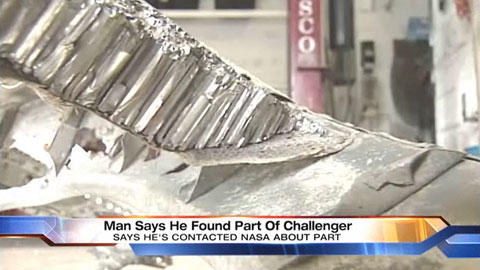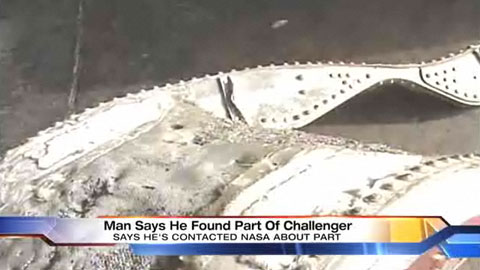|
Author
|
Topic: Report: Recovered Challenger debris (2009)
|
Robert Pearlman
Editor Posts: 49392
From: Houston, TX
Registered: Nov 1999
|
 posted 08-18-2009 08:20 AM
posted 08-18-2009 08:20 AM
   
WOKV in Jacksonville, FL reports: Jim Tull was on his boat when he found a large chunk of metal, which looks like it could be from the nose of the doomed space shuttle, Challenger. A NASA spokesman said keeping parts of a shuttle is illegal, but Tull says he's waiting for a letter back from them, and is hoping to work with the space agency. Tull said he wants to display the piece all over town, and use it as a teaching tool. All debris from Challenger (and Columbia) remains U.S. government property.WJXT offers more details and imagery of the supposed part from Challenger found by Jim Tull of Jim's Automotive in Jacksonville: "NASA's waiting to send me a letter back," Tull said. "They said, 'Hang on,' after I sent them some pictures. And they said, 'You can possibly keep it.' Maybe the one that blew up over Texas, every speck of that they need for investigation. This one here, maybe let me keep it. Go ahead and teach with it."Tull said if NASA gives him the OK to keep it, the part will make it out of the garage, and he hopes all over town. "I'll take some to the Coast Guard, take to the Captain's Club, put on display and talk about it," Tull said. Tull also says he saw similar pieces at a museum in the Bahamas. 


More images of the part from WJXT:  

For our earlier coverage of Challenger debris, see: Note to collectors: Challenger off limits. |
MrSpace86
Member Posts: 1618
From: Gardner, KS
Registered: Feb 2003
|
 posted 08-18-2009 08:40 AM
posted 08-18-2009 08:40 AM
   
I think that is kind of morbid to want to display the piece all over town. I think he should ask not only NASA, but also the family members of the crew BEFORE displaying it. I am baffled he refuses to return it until he receives an official letter. Some people...I have always been for the display of Columbia and Challenger pieces but only if it were done in a tasteful and educational way. |
jimsz
Member Posts: 640
From:
Registered: Aug 2006
|
 posted 08-18-2009 10:22 AM
posted 08-18-2009 10:22 AM
   
I wonder if he would willingly collect and wish to display the wreckage from an auto accident in which a neighbor was killed?There is plenty of video that is able to be used for a teaching tool. |
MrSpace86
Member Posts: 1618
From: Gardner, KS
Registered: Feb 2003
|
 posted 08-18-2009 11:52 AM
posted 08-18-2009 11:52 AM
   
I am surprised no one ever recovered as much debris as possible. I mean, I am sure there are still large amounts of debris just corroding away at the bottom of the ocean that eventually break apart and float to the beach. The problem would be mostly solved if an effort was made to recover whatever is left. That being said, I can't imagine how many fragments of Challenger and Columbia have turned up that a) people keep and don't say anything about or b) people see and discard. I am also surprised no federal authorities have knocked on this man's door. |
Max Q
Member Posts: 399
From: Whyalla South Australia
Registered: Mar 2007
|
 posted 08-18-2009 10:22 PM
posted 08-18-2009 10:22 PM
   
Okay, so I don't understand the issue here. Two orbiters where lost in catastrophic failures, very sad I agree. But lessons have been learned and workarounds put in place. As the causes of both failures have been worked out, what's the big deal about returning debris? |
Robert Pearlman
Editor Posts: 49392
From: Houston, TX
Registered: Nov 1999
|
 posted 08-18-2009 10:32 PM
posted 08-18-2009 10:32 PM
   
NASA never relinquished ownership of the orbiters, and therefore their debris remains government property. Anyone found retaining debris is in violation of Title 18, Section 641 of the United States Code, or plainly put, theft of government property, for which there is no statute of limitations. The debris recovered from Columbia continues to be studied by researchers, and therefore NASA has an interest to continue to catalog and archive the material. Though the same is not (currently) the case for Challenger, it is not within NASA's or the families' interest to see pieces of OV-099 being traded and/or sold. |
JPSastro
Member Posts: 170
From: Tucson, Arizona
Registered: Jan 2009
|
 posted 08-18-2009 11:09 PM
posted 08-18-2009 11:09 PM
   
Here is my issue with this... Tull also says he saw similar pieces at a museum in the Bahamas. How did this happened? All these years and this museum has alleged similar pieces on display? And nobody noticed? Nobody said anything? NASA and the government who have no issue with doing what it needs to to recover such items and they were clueless to it's existence? Something doesn't make sense. I'll have to believe a lot of tourists have seen this alleged debris. Huh. |
Max Q
Member Posts: 399
From: Whyalla South Australia
Registered: Mar 2007
|
 posted 08-19-2009 12:14 AM
posted 08-19-2009 12:14 AM
   
But do the U.S. laws cover the Bahamas? I understand that somebody must have smuggled the debris out of the States but once it's out of the country can they get it back? I will concede that its not much of a museum that would put items like this on display knowing the importance of the said items. |
Robert Pearlman
Editor Posts: 49392
From: Houston, TX
Registered: Nov 1999
|
 posted 08-19-2009 12:27 AM
posted 08-19-2009 12:27 AM
   
If the debris in question is indeed from Challenger, then it wasn't smuggled out of the United States. It was washed ashore after landing in the ocean in the aftermath of the accident.The Outer Space Treaty ("Treaty on Principles Governing the Activities of States in the Exploration and Use of Outer Space, including the Moon and Other Celestial Bodies"), which forms the basis for international space law, includes a provision that nations retain ownership of their spacecraft regardless of where it lands on Earth. A State Party to the Treaty on whose registry an object launched into outer space is carried shall retain jurisdiction and control over such object, and over any personnel thereof, while in outer space or on a celestial body. Ownership of objects launched into outer space, including objects landed or constructed on a celestial body, and of their component parts, is not affected by their presence in outer space or on a celestial body or by their return to the Earth. Such objects or component parts found beyond the limits of the State Party to the Treaty on whose registry they are carried shall be returned to that State Party, which shall, upon request, furnish identifying data prior to their return. As for the museum, there is very little known from what Mr. Hull said, which was only that there were other similar pieces to the one he found. Maybe those pieces are from space shuttles but are not wreckage from the accident, or maybe he was mistaken that they are from an orbiter altogether. More details are needed. |
GACspaceguy
Member Posts: 2892
From: Guyton, GA
Registered: Jan 2006
|
 posted 08-19-2009 05:32 AM
posted 08-19-2009 05:32 AM
   
I will be very surprised that this turns out to be part of the Challenger. I have a couple of reasons for this opinion. One, after 23+ years in the salt water of the ocean there is a lack of significant corrosion. The material specifically that gives me that clue is the picture of the aluminum honeycomb core that is exposed, it shows clean. Also, the bolt shown would be heavily corroded after that length of time rather than the surface corrosion shown. I have seen a lot of corroded structure in my day and these pieces look very clean. Second there is a lack any "sea growth" it may have been cleaned off but the remaining material should be significantly discolored. If this is confirmed as Challenger material I suggest it has not been in the ocean since the disaster. |
328KF
Member Posts: 1372
From:
Registered: Apr 2008
|
 posted 08-20-2009 09:09 PM
posted 08-20-2009 09:09 PM
   
The debris shown certainly appears to be aircraft structure of some sort. I agree that the honeycomb material looks awfully new and uncorroded. The rest of the metal looks like a lot of structural parts and fasteners I have seen over the years on large aircraft.However, the white "paint" seems a bit strange. Most aircraft leave the frame with that green zinc-chromate primer, except for some floor beams and interior parts. I recall space shuttle assembly photos showing the green primer color, not white. The "owner" does not clearly state where or how he found it while in his boat. It looks far too heavy to have been floating on the surface. |


















